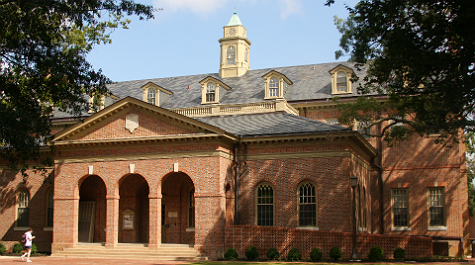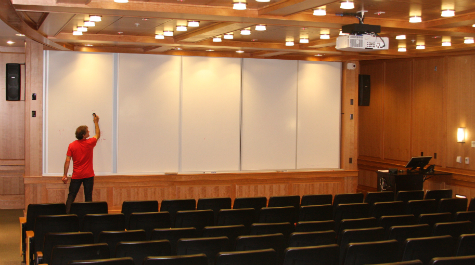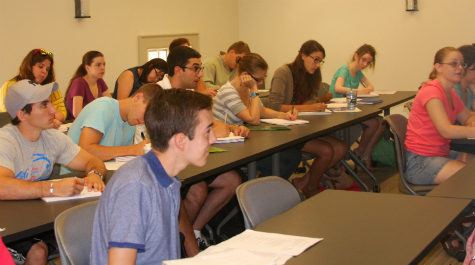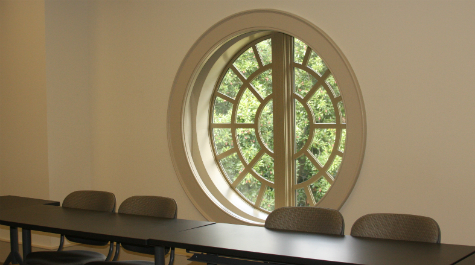Tucker Hall renovations finish
Like a great caterpillar, Tucker Hall has sat cocooned inside green construction fences for the last year as workers within carried out a manmade metamorphosis. Now reopened for classes, the butterfly that is Tucker Hall has emerged from its fencing as a 21st century academic building with years of service in its future. Many improvements are already apparent to faculty and students settling into the new structure.
In 2009, the English department temporarily moved to Tyler Hall in anticipation of the renovation. For upperclassman English majors who have taken most of their major classes in Tyler Hall, the move back to Tucker Hall is a welcome one.
“There’s this big sitting area that’s great for students to hang out in, the layout is nice and the lighting is a lot better than just about all the other buildings,” said Cassie Medeiros ’14. “I’m definitely excited to move here.”
Tucker Hall, which first opened in 1909 as the College’s first freestanding library, lies on the north side of the Sunken Garden near the Wren Building. The building has since been expanded multiple times and, in 1968, began housing the William & Mary Law School under the name Marshall-Wythe Hall. After its last renovation in 1980, the English department moved into it as the newly renamed Tucker Hall, named for William & Mary’s second professor of law, St. George Tucker.
Given that the building’s previous renovation took place over three decades ago, Tucker Hall was due a facelift.
“Essentially, all the systems in the building needed work. For example, there were longstanding issues with leaks in ceilings, with the plumbing and other aspects. There were multiple levels in the building and poor use of space. Accessibility and technology needed to be improved,” said Anna Martin, vice president for administration. “A general, complete reworking of the building was needed to make it useful for today’s teaching.”
After completing design work, the renovation project was on hold until the state allocated $11 million for the project in 2011. Construction began in fall 2012 and was complete in time for classes this semester. According to Martin, the remaining minor work is set for completion by the end of October.
“The construction team worked very hard to get that building finished just in time for classes,” Martin said.
When the English department faculty and staff officially moved into their new quarters Aug. 31, they were greeted by a variety of new features added during renovation.
Glass-walled classrooms now greet the visitor to Tucker Hall on both sides upon entering the building’s front door. While many students bypass the central staircase to reach the opulent lecture theater in the building’s rear, others ascend the symmetrical stairs and find themselves in a new atrium lit by daylight streaming in through the roof cupola.
The atrium provides an informal space with ample electrical outlets for student gatherings or small presentations. The cupola perhaps best illustrates one of Tucker Hall’s most apparent new features: its lighting.
“I’m just knocked out by the cupola. It’s a wonderful idea and it really worked out so well,” Martin said. “The architects created a terrific design that revitalized an important historic structure.”
From the glass-walled classrooms (already called “the fishbowls” by students and faculty), to the upper floor seminar rooms dominated by round windows, Tucker Hall is designed to bring light to lectures—something professors appreciate.
“A lot of creativity went into making sure the student experience is upgraded, and it’s clearly substantially improved in that regard,” said Brett Wilson, associate chair of the English department and director of the English honors program. “I teach in the glass ‘fishbowl’ room, and I think it does make the building seem lively—that’s the part that I like the best.”
Shanay Butler, the English department’s administrative assistant, sees benefits in the new building that go beyond academics.
“We have access that we didn’t have before to accommodate many more things. We can do a lot more talks, we can do a lot more events, and students have more places for organization meetings,” Butler said.
When the moving boxes are put away and its occupants finish settling in, Tucker Hall will be ready to serve William & Mary for years to come.
“In the end, I think it’s a building that is much more user-friendly than it was before, a much more habitable, pleasant building to work and learn in. It also adds another venue for small presentations and events. All around, it’s a revitalized building,” said Martin.


















